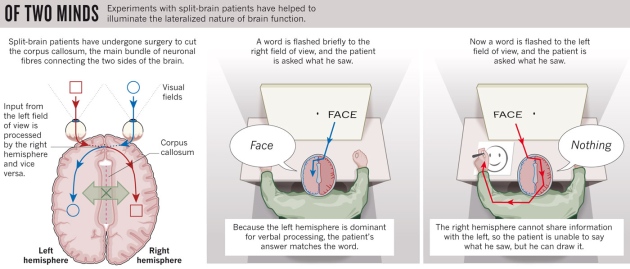Split brain means that when the corpus callosum is damaged it does not allow the right and left hemisphere to exchange information. Even though the corpus callosum is damaged small amounts of information still travel between the hemispheres thru several smaller commissures.
For people who do have sever epilepsies having a brain split procedure done will help prevent the epilepsies because the right and left hemispheres would not be crossing information that may cause the epilepsy from happening.
If patients with split brains' are shown a picture to his/her left visual field will be unable to say what they see but would be able to draw it out, as shown in the picture below. And if shown to his/her right visual field the patient would be able to announce what he says, particularly because for most people the left hemisphere is language dominance.

Michael Gazzaniga has conducted experiments and studies for more than 50 yrs with patients who have split-brain. Heres a video from early research on animals with split brain and how the brain works.
On a final note, its still incredible how the brain works and is still able to change in a few ways to make life easier for us, even after people with epilepsy have had split brain surgery, and there are not large amounts of information exchanging, other forms of axons adapt to ways to send smaller messages through the brain and to the rest of our body.
Before reading this i never thought that split brain was possible but now i see that it is. I did not know that a split brain person functions like the way your picture says they do. I found it fascinating how they can see the word and draw the meaning of it but are not able to say the word out loud.
ReplyDeleteSplit-brain people are very interesting subjects. I couldn't believe the wealth of knowledge we gained from conducting such crude surgical procedures on people, but they did actually benefit from these surgeries, so I suppose it was a win-win. I don't think we could've learned very much about the lateralization of brain functioning until we conducted these procedures.
ReplyDelete